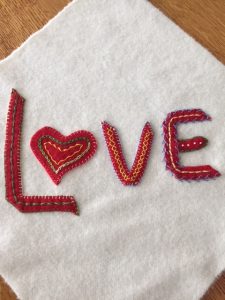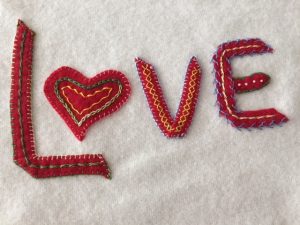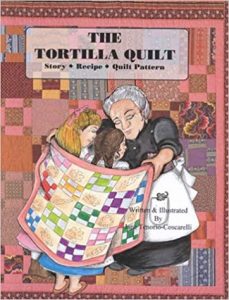Playing with Needle and Thread
By Judy Moore Pullen
Yesterday I had the pleasure of presenting a program on “The Wonderful World of Wool” at the Colorado Valley Quilters’ Guild in La Grange, Texas, home of the Texas Quilt Museum. What an amazing group of ladies whose hearts and hands serve not only their families, but their community as well. Many serve as docents for the museum, provide books and quilts for families, and share their talent and creativity with others.
One of the wonderful things about wool is that I can play with threads. John James Chenille Needles, sizes 18-26 provide the opportunity to use beautiful Presencia Finca Floss and all sizes of Presencia Perle Cotton threads.
I have convinced myself that the older I get, the bigger my number, the “finer” I get. This helps me remember that the bigger the number, the finer the thread and hand sewing needles. Machine sewing needles are just the opposite. Presencia Perle Cotton threads, sizes 3, 5, 8, 12, and 16 are the same: the bigger the number the finer, smaller the diameter of the thread.
John James Chenille Needles have a larger, very smooth shaft that opens the fibers on wool. Those wool fibers of course, close again after the thread is pulled through. Presencia Perle Cotton size 5 can easily be threaded through the elongated eye of a size 18 chenille needle. Try playing with a combination of a strand or 2 or 3 of Presencia Finca Floss with a contrasting color of Presencia Perle Cotton and stitch at the same time. Perhaps you would like to test this thread combination on a scrap of wool before stitching on your project or throw caution to the wind and just begin stitching!
I also like to play with what I call a “wrap” stitch. I sew a running stitch line of Perle Cotton size 8, solid color, on a scrap of wool, making my stitches about ¼” long. With a contrasting color of Perle 8 and a John James Tapestry Needle, size 22, I come up from the back of the wool at the bottom of the line of stitching. Then I slide the needle just under the first thread from right to left, not stitching through the wool. A tapestry needle is dull, so I can easily slide my needle under the next stitch, right to left, and continue with this pattern. Try it, and take a look at what you have created. Consider doing the “wrap” down the line of running stitches to where you began with yet another color of contrasting thread. Think of all the times you can use these great decorative applique stitches and have fun while playing.

Wool applique wrap stitch example

Up-close view of wool applique using Presencia threads
I think we have some new wool applique enthusiasts from the Colorado Valley Quilt Guild. They also seemed to enjoy seeing all the options and surprises that can result from playing with needles and threads. The choices are endless, and the process is fun and rewarding.
Happy stitching,
Judy Moore Pullen

